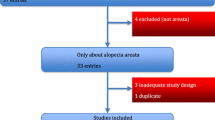Abstract
Background
Recent experimental data suggest a role for apremilast in the treatment of alopecia areata. Small clinical studies have so far provided contradictory results.
Objectives
We retrospectively evaluated the efficacy and safety of apremilast in five cases of extensive and treatment-resistant alopecia areata.
Materials and Methods
Apremilast was given at a dose of 30 mg, twice daily, over six months. The efficacy of apremilast treatment was determined by monthly assessment of the affected scalp surface area using SALT scoring.
Results
In four out of five patients, no sustained improvement in SALT score was observed within the treatment period. Two of these patients had a slight but only transient improvement after two months of treatment. One patient responded to apremilast treatment with a progressive and marked improvement, as reflected by an 83% reduction in SALT score.
Conclusion
Our results are in line with the varying treatment responses in previous studies. Future studies on the efficacy of apremilast treatment in confirmed alopecia areata patient groups are warranted.
Similar content being viewed by others
References
Renert-Yuval Y, Guttman-Yassky E. A novel therapeutic paradigm for patients with extensive alopecia areata. Expert Opin Biol Ther 2016; 16: 1005–14.
Madani S, Shapiro J. Alopecia areata update. J Am Acad Dermatol 2000; 42: 549–66.
Finner AM. Alopecia areata: clinical presentation, diagnosis, and unusual cases. Dermatol Ther 2011; 24: 348–54.
Darwin E, Hirt PA, Fertig R, Doliner B, Delcanto G, Jimenez JJ. Alopecia areata: review of epidemiology, clinical features, pathogenesis, and new treatment options. Int J Trichology 2018; 10: 51–60.
Renert-Yuval Y, Guttman-Yassky E. The changing landscapeof alopecia areata: the therapeutic paradigm. Adv Ther 2017; 34: 1594–609.
Aghaei S, Saki N, Daneshmand E, et al. Prevalence of psychological disorders in patients with alopecia areata in comparison with normal subjects. ISRN Dermatol 2014; 20: 3043–70.
Price VH, Hordinsky MK, Olsen EA, et al. Subcutaneous efalizumabis not effective in the treatment of alopecia areata. J Am Acad Dermatol 2008; 58: 395–402.
Delamere FM, Sladden MM, Dobbins HM, et al. Interventions for alopecia areata. Cochrane Database Syst Rev 2008: CD004413.
Otberg N. Systemic treatment for alopecia areata. Dermatol Ther 2011; 24: 320–5.
Kurosawa M, Nakagawa S, Mizuashi M, et al. A comparison of the efficacy, relapse rate and side effects among three modalities of systemic corticosteroid therapy for alopecia areata. Dermatology 2006; 212: 361–5.
Acikgoz G, Caliskan E, Tunca M, et al. The effect of oral cyclosporinein the treatment of severe alopecia areata. Cutan Ocul Toxicol 2014; 33: 247–52.
Farshi S, Mansouri P, Safar F, et al. Could azathioprine be considered as a therapeutic alternative in the treatment of alopecia areata? A pilot study. Int J Dermatol 2010; 49: 1188–93.
Keren A, Shemer A, Ullmann Y, et al. The PDE4 inhibitor, apremilast, suppresses experimentally induced alopecia areata in human skin in vivo. J Dermatol Sci 2015; 77: 74–6.
Magdaleno-Tapial J, Valenzuela-Onate C, Sánchez-Carazo JL, Alegre-de Miquel V. Improvement of alopecia areata with apremilast. Australas J Dermatol 2019; 60: 144–5.
Lopez SD, Castro C, Calzada P, et al. Alopecia areata and severe psoriasis successfully treated with apremilast. Arch Clin Dermatol 2017; 1: 2.
Taneja N, Gupta S. Apremilast is efficacious in refractory alopecia areata. J Dermatolog Treat 2019; 6: 1–3.
Estébanez A, Estébanez N, Martin JM, Montesinos E. Apremilast in refractory alopecia areata. Int J Trichology 2019; 11: 213–5.
Sakakibara M, Shimoyama H, Nomura M, et al. Efficacy of the phosphodiesterase-4 inhibitor, apremilast, in a patient with severe alopecia areata. Eur J Dermatol 2019; 29: 436–7.
Liu LY, King BA. Lack of efficacy of apremilast in 9 patients with severe alopecia areata. J Am Acad Dermatol 2017; 77: 773–4.
Mikhaylov D, Pavel A, Yao C, et al. A randomized placebocontrolled single-center pilot study of the safety and efficacy of apremilast in subjects with moderate-to-severe alopecia areata. Arch Dermatol Res 2019; 311: 29–36.
Suarez-Farinas M, Ungar B, Noda S, et al. Alopecia areata profiling shows TH1, TH2, and IL-23 cytokine activation without parallel TH17/TH22 skewing. J Allergy Clin Immunol 2015; 136: 1277–87.
Claveau D, Chen SL, O’Keefe S, et al. Preferential inhibition of T helper 1, but not T helper 2, cytokines in vitro by L-826,141 [4-[2-(3,4-Bisdifiuromethoxyphenyl)-2-[4-(1,1,1,3,3,3-hexafiuoro-2-hydroxypropan-2-yl)-phenyl]-ethyl]3-methylpyridine-1-oxide], a potent and selective phosphodiesterase 4 inhibitor. J Pharmacol Exp Ther 2004; 310: 752–60.
Guttman-Yassky E, Ungar B, et al. Extensive alopecia areata is reversed by IL-12/IL-23p40 cytokine antagonism. J Allergy Clin Immunol 2016; 137: 301–4.
Author information
Authors and Affiliations
Corresponding author
Additional information
Disclosure
Conflicts of interest: none. Funding: none.
About this article
Cite this article
Weber, B., Radakovic, S. & Tanew, A. Apremilast for extensive and treatment-resistant alopecia areata: a retrospective analysis of five patients. Eur J Dermatol 30, 165–168 (2020). https://doi.org/10.1684/ejd.2020.3749
Accepted:
Published:
Issue Date:
DOI: https://doi.org/10.1684/ejd.2020.3749




